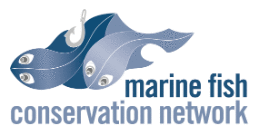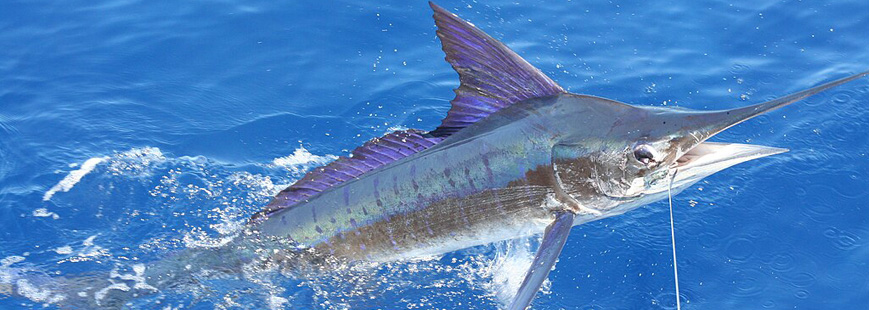This article is reprinted with permission from the Fall 2024 Wild Oceans Horizon Newsletter. Top photo by Jackiemora01 via Wikipedia
The Western and Central Pacific Fisheries Commission (WCPFC), the international body responsible for ensuring the long-term conservation and sustainable use of highly migratory fish stocks in the western and central Pacific, met in Suva, Fiji in December for their annual meeting. At the meeting, the United States spearheaded the adoption of the first ever international catch limits for the steadily declining stock of north and central Pacific striped marlin. Their tenacity and willingness to make conservation the number one priority has finally put striped marlin on a path to recovery.
Tuna management usually captures the majority of the WCPFC’s attention. That figures since the Pacific Ocean accounts for more than 70 percent of the world’s commercially landed tuna and the Pacific tuna catch is worth more than $22 billion annually. However, WCPFC’s duty encompasses not only the sustainable management of various tuna species, including skipjack, yellowfin, bigeye, albacore and bluefin, but also other highly migratory species and their marine ecosystems.
This year, the meeting focused on often overlooked conservation issues such as seabirds, sharks, and marlins, pushing the delegates to consider the impact of tuna fishing on the long-term sustainability of other species. As we have done for years at this forum, Wild Oceans once again strongly advocated for adoption of a conservation measure to limit the ocean-wide catch of striped marlin. We met stiff resistance from parties seeking to delay, trying to discount the science, and placing blame on others in order to avoid accountability, but ultimately conservation prevailed.
It’s easy to pin marine conservation problems on foreign scapegoats. But, in doing so, we erode any effort to genuinely confront the problem. This seemed the predictable playbook for nations fishing striped marlin. By faulting Japan’s historic drift gillnet fishery for the decline of Pacific striped marlin or attributing the languishment of the stock at historically low levels to China’s emerging high-seas fishing, we can deflect blame. Asserting that fault lies elsewhere or ignoring the best science has hindered conservation for decades. These excuses have kept delegates from focusing on efficiently solving the problem of unlimited fishing pressure on striped marlin.
The United States broke this cycle with a proposal that requires international cooperation. The newly adopted striped marlin conservation and management measure sets annual catch limits (including discards) for the five nations with significant striped marlin catch, including Japan, Taiwan, Korea, U.S. and China. The measure reduces the U.S. catch from the recent and historically high levels to 228.4 metric tons (mt) per year. However, it also allows the roll-over of 150 mt of unused quota from other countries to the U.S. If everyone cooperates and holds catch near current levels the U.S. quota increases to 378.4 mt. At the same time, ocean-wide fishing mortality is reduced and the stock rebuilds. However, if the international cooperation experiment fails, and nations exceed quotas, the stock will continue to slide.
This new striped marlin management measure became operative at the beginning of 2025. The WCPFC will review the measure in 2027, after completion of a new stock assessment. In the intervening years, U.S. fishermen have an opportunity to demonstrate techniques to avoid striped marlin through gear modifications or fishing location. The fleet has already adopted circle hooks but could continue promising research to eliminate or lower the hooks that most frequently catch marlins. For our part, we will continue to ask for inclusion of these boat-side measures in all future negotiations.
This year, NOAA Fisheries updated their Ecosystem-Based Fisheries Management (EBFM) Policy and published a new Road Map that creates links between the EBFM Policy and climate-ready fisheries, and focuses on improving the integration of science and management.
Wild Oceans has strongly supported the agency’s work to advance our understanding of ecosystem processes. The initial draft Road Map included many well thought-out and important Action Items that can help fundamentally change the way we manage by providing managers and stakeholders with a better understanding of the impact of the ecosystem on fisheries, the impact of fisheries on other fisheries, and the impact of fisheries on the ecosystem. However, the initial draft had a disconnect between providing managers with the ingredients of EBMF and a recipe to successfully manage fisheries from an ecosystem perspective. Wild Oceans and our allies felt that the draft Road Map needed to better connect NOAA science to management to achieve EBFM and build climate-ready fisheries. These needs were the motivation for our submission of a public comment and to organize with like-minded partners.
History demonstrates that EBFM is an iterative process and that NOAA Fisheries and the councils can and must act now to integrate foundational EBFM principles, such as protecting forage fish, into management and “plan for, absorb, recover from, and more successfully adapt to adverse events.” The draft Road Map overlooked near-term opportunities to operationalize EBFM and make climate-ready management decisions. For example, science products will be more useful if they translate ecosystem information into decision criteria that can inform councils of when and under what conditions intervention might enhance progress towards EBFM.
Our public comments surrounded the idea that the 2024 Road Map should provide stronger direction for prioritizing scientific understanding and protection for critical forage fish species, which are actively collapsing along the Atlantic Coast. Conserving forage species at the ecosystem level requires a change in some of our most basic fishery management concepts. Preventing ecosystem overfishing, which jeopardizes the integrity of marine communities, means moving away from the goal of maximizing yields and toward ecologically sustainable yields. To do that, we must be more forthright about how we are impacting the food web and then overtly consider these impacts within our conservation and management strategies.
We commend NOAA Fisheries’ decision to think big in the Road Map and recognize that EBFM management challenges cross ocean basins and that addressing challenges at varying spatial scales and with partners across multiple jurisdictions can support ecosystem resilience. We urged NOAA Fisheries to consider how to tailor tools to address the complex management of highly migratory species and their habitats domestically and internationally.
When the final version of the Road Map was released, we were excited to see that NOAA had provided significantly more guidance for how it would engage with management partners, fishermen, and Indigenous People in efforts to advance EBFM. This included the addition of an entirely new Goal in the Road Map. Furthermore, the final version of the Road Map included provisions for developing and expanding approaches to research the implications of essential fish habitats and forage fish in climate-dynamic fisheries management.
We look forward to collaborating with NOAA Fisheries as we engage in a new way of thinking and managing that considers ecosystem level impacts and action and secures the resilience of our marine habitats and fisheries.
See Wild Oceans’ full comment letter on NOAA’s EBFM Road Map.


